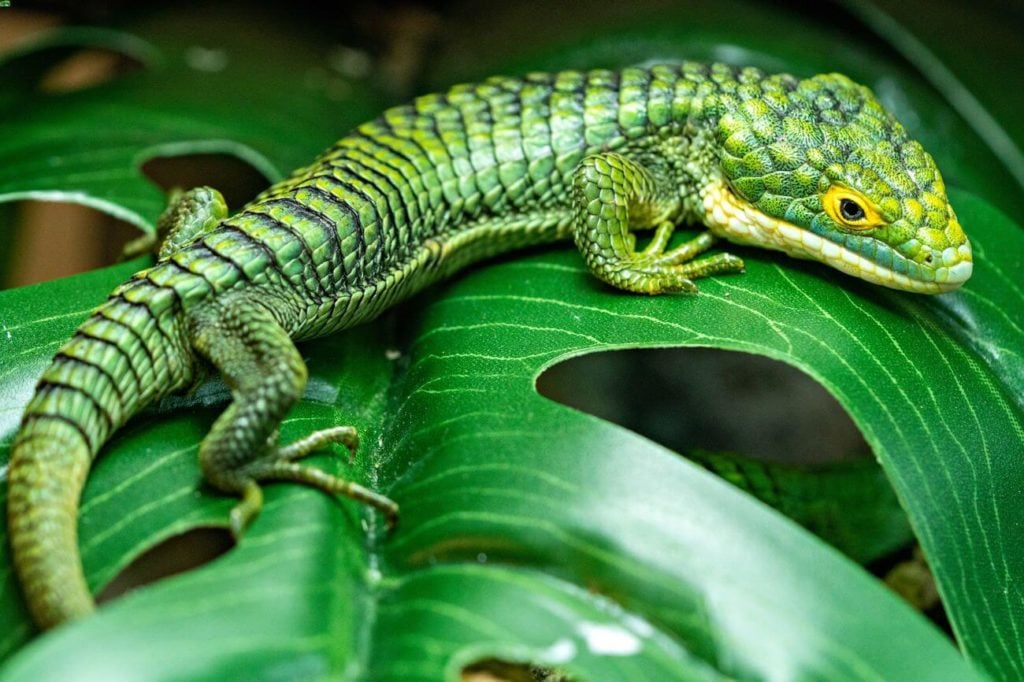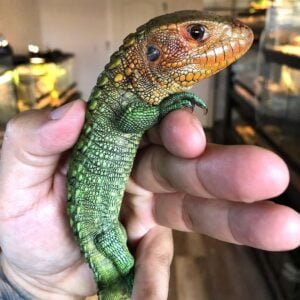No products in the cart.
Return To Shop
Whatsapp +1 (650) 437-5747
info@redboxreptiles.com
redboxreptiles667
30% off for Bitcoin Payment $1000+
Free standard shipping on orders $500+
Abronia Graminea
$120.00 – $330.00
30 people are viewing this product right now
The Mexican alligator lizard (Abronia graminea) is also often known as the green arboreal alligator lizard. This is an endangered species that can be found in areas of Mexico such as Oaxaca, Veracruz and Puebla. Because this is an endangered creature, it is important to purchase your lizard from a very reputable dealer.
It’s known for having quite a distinct and beautiful look. Many people think it looks like a creature from a fantasy movie!
We feel that this lizard is the match for someone with intermediate to advanced reptile care experience. This is because it has some very specific care and handling requirements that are better suited to someone above a beginner’s level.
Appearance & Colors
These gorgeous lizards are best known for their bright green skin, eye color variations and prehensile tails. Their clearly defined scales give them a very unique and textured look that many people absolutely love.
Because they spend much of their time in trees, they have strong legs and toes that are perfect for climbing. They have a fairly thick tail that can be used for counterbalancing to assist them while they’re in trees as well.
Mexican Alligator Lizard Size
The usual Mexican alligator lizard size is around 12 inches when full grown. If you’re looking for a pet lizard but are short on space, then the Mexican alligator lizard is perfect.
Expert Tip: This length can be a little deceptive at first, because more than half of it is made up of the tail! This reptile may be little, but you’ll find that it is packed with personality. The combination of their small size and vibrant colors is something to see!
Lifespan
The lifespan of a Mexican alligator lizard can reach up to 20 years in captivity. That makes them a great pet reptile for anyone willing to take on a long-term care commitment.
With the right conditions and good husbandry, Abronia graminea will bring years of enjoyment and fascination.
Mexican Alligator Lizard Care
Mexican alligator lizard care is best for owners who have intermediate to advanced experience taking care of exotic reptiles. If that describes you, then you’ll definitely enjoy these lizards!

Despite the fact that Abronia graminea requires quite a bit of specific care and a very regulated environment, we think that you’ll find the effort well worth it. Give this lizard a well-designed habitat, the right heat and lighting and a balanced diet, and you’ll have a pet to enjoy for many years.
The one thing to remember is that Mexican alligator lizards can be easily stressed, and that stress can lead to health issues. It’s important to know what bothers your lizard to avoid any triggers.
Enclosure Size
You’re not going to need a very large enclosure for your Mexican alligator lizard, but you should not go any smaller than 24 by 24 by 36 inches. If you have room, a larger enclosure would certainly be fine. Just remember to focus on the height of the enclosure rather than its length.
Because the living space of a Mexican alligator lizard requires plenty of ventilation, glass enclosures shouldn’t be used. Instead, go for a screened living space. It will look nice, and you will have plenty of cross ventilation.
Expert Tip: No matter what size of an enclosure you use, make sure that it has a tight fitting lid. These reptiles can be quite the escape artists, so be careful!
What To Put In Their Habitat
With a little advanced planning and some creativity, you can design a living space for your lizard that’s the perfect combination of form and function. As long as you have the basic elements and plenty of enhancements, you can make an enclosure that is pleasing to both you and your Mexican alligator lizard.
The first thing you’ll need to do is to decide on a substrate. Acceptable substrates include paper towels, newspaper, sphagnum moss or peat moss.

Our suggested substrate is sphagnum moss because it retains moisture, and that helps to keep humidity at the correct level. Mexican alligator lizards like to burrow, so make your substrate layer several inches thick.
As far as enclosure enhancements go, good items to add are real or artificial plants, reptile hides, branches, logs and pieces of cork.
We like to use live plants, like bromeliads, ficus or porthos, in our enclosures. Live plants not only add a beautiful, natural touch to the area, but they help to retain moisture (we’ll cover the importance of that later).
Expert Tip: Feel free to change things around or add and subtract habitat items as needed. As long as you’re not shuffling things too often, it’s never a bad idea to search for the optimal setup!
Temperature & Lighting
It’s going to be very important to have at least one thermometer in your lizard’s enclosure. This is because you are going to need to maintain a temperature gradient within the enclosure, and using several thermometers will ensure that you are getting the temperatures just right.
Here’s what to aim for:
- For the basking side of your set-up, you’ll need to maintain a temperature of between 80 and 82 degrees Fahrenheit.
- The other side (which will be cooler), should remain between 70 and 78 degrees Fahrenheit.
- At night, it’s alright if the temperature drops into the 60’s. Mexican alligator lizards are used to cooler temperatures.
For your basking area, all you really need is a low watt bulb that is placed outside of the enclosure. Overheating your Mexican alligator lizard can be very dangerous, so make sure that the basking area is not getting above the required temperature.
If you are not able to expose your Mexican alligator lizard to natural sunlight, you’ll need to provide supplemental UVB lighting. This can be done using a tubular or a coil UVB bulb. In our opinion, the tubular kind seems to work better, but either one is fine.
Use a 12 hours on, 12 hours off schedule for your lighting. This can be ensured quite easily with the use of a timer.
Humidity
Mexican alligator lizards need a pretty humid environment, and a level of 80 percent is the sweet spot. Humidity levels that stray too far away from that number can lead to serious health complications for Abronia graminea
Expert Tip: Levels can drift up to 90 percent on occasion, but try to keep the level at 80 percent. That’s not something that can happen consistently.
You have a couple of options for keeping the humidity level so high. You can use a hand mister twice a day, or you can install a special reptile fogger.

Having a good substrate and putting plants in the enclosure can help with humidity as well. It might take a little bit of trial and error to find the right setup that keeps things stable (and saves you from misting more than you have to).
Water
Mexican alligator lizards will drink the water droplets that form after you mist the enclosure, so you won’t need to create any special kind of watering system for them. That makes them rather low-maintenance in this regard!
The only thing you need to consider is ensuring that the water you’re misting the enclosure with is safe. Make sure it’s free of chlorine or other harmful chemicals, and your pet will be just fine.
Food & Diet
Your Mexican alligator lizard will enjoy being fed a variety of items such as crickets, grasshoppers, mealworms, snails and butter worms.
For maximum nutritional benefit, make sure to gut load these insects first. You can use kale, lettuce or fruits to gut load your insects. You’ll also need to dust the prey with supplemental calcium and vitamin powders prior to feeding time.
It’s also important to ensure that you’re practicing smart feeding habits as well. Here’s what to do:
Put the food items in a small bowl, and remove anything that’s left over at the end of the day. You can start off giving your lizard 10 to 15 insects at a time, two to three times a week. You can always increase or decrease the amount of food given.
Expert Tip: Be careful not to overfeed your Mexican alligator lizard since these reptiles can quickly become overweight (leading to a long list of possible health issues).
Potential Health Issues
Mexican alligator lizards seem to be prone to most of the same health issues as other pet reptiles. Some of the most common ones are parasitic infestations, respiratory infections, metabolic bone disease and mouth rot.
If detected early, these issues can usually be cleared up quickly, so having a good relationship with your veterinarian is going to be important.
That’s why it’s also smart to check in on your Abronia graminea regularly to see if anything looks concerning. A lack of energy, a loss in appetite, or other obvious physical changes are all reasons to get them looked at.
You should also make sure to take your Mexican alligator lizard into the vet for a regular checkup. It’s something that many owners get lazy with, but it makes a big difference.
Expert Tip: It’s also worth pointing out that great care will go a long way in preventing these health issues from occurring. Prevention is always the best plan of attack!
Behavior & Temperament
These arboreal, diurnal lizards have a pretty gentle temperament. While they can bite, this will pretty much only happen if they feel scared (which you can influence).
As usual, you should always use caution when handling them. Mexical alligator lizards don’t enjoy being handled frequently, so respect their preferences.
In terms of activity level, Abronia graminea stay fairly busy in their enclosure. As an owner you’ll witness a lot of climbing and fun displays when it’s time to eat!
Handling Them
Mexican alligator lizards don’t really like to be handled too much, and they will often show signs of stress from overhandling. While they are not known to be particularly aggressive, they will bite if they feel threatened or if they are stressed out.
With time and patience, you may get your lizard to tolerate a bit of handling, but it will always prefer to be left alone. It’s best to reserve handling for situations where you need to work in the enclosure (although most of the time they won’t be in the way) or if you need to take them to the vet.
Conclusion
Mexican alligator lizard care is definitely something that requires some experience to be done properly. When you add that to the fact that this species is endangered, it’s yet another incentive to make sure you know what you’re doing before you buy one.
But if you’re confident in your skills and want to own this beautiful reptile, give it a shot! We’ve been a big fan of Abronia graminea for years, and know plenty of owners who have nothing but great things to say about them.
| AGE/SIZE | Hatchlings, Well Started Babies, Young Adults |
|---|
Only logged in customers who have purchased this product may leave a review.
Juvenile Dwarf Caiman
$450.00


Abronia Lythrochila
$740.00
Related products
Copyright © 2024 REDBOX REPTILES.









Reviews
There are no reviews yet.